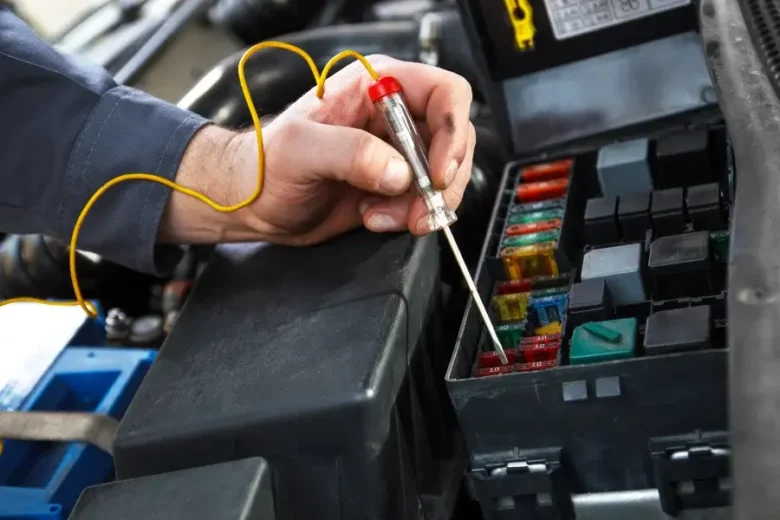Have you ever found yourself stuck in the parking lot where your car fails to start? Car troubles can be really annoying, especially those that arise from an unwelcome electrical fault. These situations usually strike at the most inopportune times and leave you frustrated and upset. It is important to have some knowledge of what can cause these to help any car owner manage these problems.
Difficult to start an engine with a burning light turning on or a popping fuse is just one of the many forms electrical defects can take. Some of these family members, however, are not easy to solve. This is a practical guide to the automotive electrical system, and you don’t have to be an expert mechanic to appreciate these aspects of your vehicle. So here’s the short step-by-step tutorial on how to detect and correct an electrical fault in your car.
Common Symptoms of Electrical Issues in Cars:
There are many types of automobile electrical failures that a car owner should be familiar with. The most usual signs that could be indicative of such symptoms are dim or flickering headlights. If your lights are acting up, it might indicate a problem with the alternator or battery.
There are some other unusual symptoms that one can expect and that are not directly seen because of an engine. The most common is the engine turning but not starting, which produces some clicking noise. Clicking sounds usually indicate that there is something wrong in the connections to the starter motor or battery.
Dashboard warning lights engaging can also be noticed at times without clear reasons. These icons serve as alerts and are for various systems, so don’t ignore them.
Accessories such as radios or windows can also be an indicator of electrical problems in a car when there is a variation in their operational power. This concern can be narrowed too advanced wiring defects or a worn-out, dying fuse.
After deep discharges of the car a number of times and in the absence of negative factors, the battery should be closely examined for other underlying factors that should usually be addressed. For most of the time, it indicates other underlying trouble, which doesn’t usually issue.
An Overview of the Electrical System in Cars:
The electrical system within cars is made up of a network that is cut close to the edges that transfers energy to the different electrical components that there are. In its simplest form, the battery is an energy storage unit and provides the initial voltage needed to crank up the engine. This is necessary to start the engine and run the electrical systems. After that, it is the alternators that take control. This substitutes energy for the battery, lights, radio, and all electronic components. There is a kind of homeostasis through such interlinks and interdependence. These critical elements are linked with wiring harnesses. These carry electrical energy around the vehicle in different locations while preventing short circuits and overloads where possible.
Fuses are important components too; they protect the circuitry when current is higher than what the circuit is designed to handle by interjecting within the circuit. It is possible to assess this system and even identify the problems in advance, which makes it much easier to fix any problem in the future. Understanding how all these functions relate can help you avoid costs later.
Top 5 Most Common Electrical Problems in Cars:
Electrical problems may impede you while driving and change your mood completely. Below are five electrical issues that are often faced by car owners.
- The number one problem is dead batteries. Eventually, due to reasons such as age, a battery is bound to lose charge, and you can find yourself in trouble where the battery is the only answer.
- Next is alternator problems. When you’re on the road and notice your lights getting dim or an electrical gadget is in use and stops working, it could indicate the alternator is going bad.
- Another common problem is blown fuses. These are minimalist structures that insulate components from electrical overflow yet can also burst during certain workloads, needless to mention, they carry their own sets of challenges.
- There are also wire problems that arise with time. These are the brittle or frayed wires that involve some overheating and short circuits, and such are especially dangerous.
- There are also ignition switch failures. Sufferers of the above disease have observed that nothing happens after turning the key in the ignition, which is the final act in starting the vehicle.
Troubleshooting and Do It Yourself Repair:
The first thing to do is check the battery. It is not uncommon to find that the ratio provides a poor or flat battery as the cause of electrical faults. Ensure that the terminals are tight and free from corrosion. Moving on, check the fuses. Some fuses blow, and in that event, fuses can be changed and systems like the lights and the radio can be switched on. Wire issues too can also give us headaches. Look out for worn-out cables that can short circuit or joins that are rather loose. Exposed wires can be insulated effectively for the moment to temporarily correct the situation.
Do check your alternator as well. Your battery may be okay, but doing nothing as you try to start your vehicle sometimes makes no sense. For dashboard warning lights, precious time and effort can be saved if the car owner turns to the owner’s manual before attempting any repairs. At times it would be as simple as a deficiency of cavity oil, no fluid, or problems with the sensor mounts rather than something really advanced. Proceeding in this fashion will enable you to fix small issues on your own without the immediate need for help from professionals.
Conclusion:
Car electrical problems are an infant problem that plans out to suffer every regular individual in their daily life use of the vehicle. However frustrating they may be, looking further past their apparent symptoms will help you tackle the problem efficiently. These signs and symptoms most of the time are special. Ignoring these signs at the beginning may cost you more with the repair process; hence, it is always advisable to act quickly. Conducting a maintenance practice regularly on the car makes it possible to avert the problem or prolong its lifespan. Simple and quick checks on batteries, fuses, wiring, and other related problems can minimise the risk of bigger problems in the future.
Possessing fault-finding skills is advantageous to a driver. It is crucial to understand when a do-it-yourself approach is positively logical and when one should leave such tasks to professionals’ lever. Being aware of one’s checking and being aware of an automobile’s computer system helps build assurance in driving. It is prudent to have such knowledge in order to avoid possible breakdowns in a car’s technological system.
FAQs:
1. What is the first indication of a compromised battery?
Some of the common signs are the lights on the dashboard, like the headlights dimming, or the vehicle struggling to start, often needing multiple tries. If you are going through these, the battery Saga is upon you.
2. How frequently should I expect to get an alternator checkup?
Every 30,000 miles is comfortable for an upgrade, though your alternator should be checked for visibly damaging electrical defects like lights going on and off randomly.
3. Am I able to repair an electrical problem without getting help from someone else?
Most of the time, an ordinary person can fix simple issues with simple knowledge and skills. Otherwise, more complex ones should be done by professionals to prevent complications and worsening the situation.
4. How long does an automobile’s battery last?
Most batteries last between three and five years with standard care. With some care, this can be lengthened.
5. Are there any measures that can be taken to remove electrical issues?
Inevitably! If the connections are cleaned and regular checks within the service time periods are undertaken, such issues will also go down.




